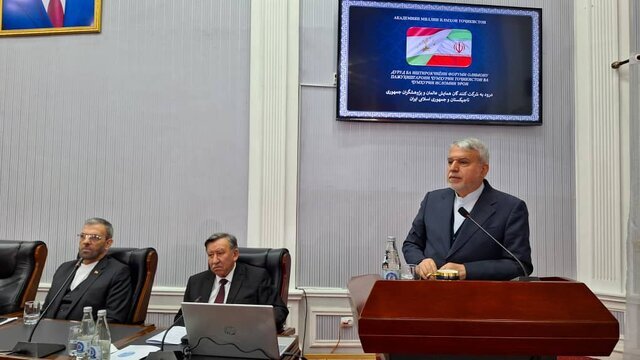Minister advocates for joint research on Persian dialects during Tajikistan visit

TEHRAN- Iran's Minister of Cultural Heritage, Tourism, and Handicrafts Seyyed Reza Salehi-Amiri has proposed conducting research to identify and introduce the shared dialects of the Persian language between Iran and Tajikistan.
During his visit to the National Academy of Sciences of Tajikistan on Thursday, Salehi-Amiri, along with his accompanying delegation, met with Tajikistan's top scientists and academics, ISNA reported.
In a bid to strengthen cultural ties between the two nations, the Iranian minister called for joint linguistic research initiatives to promote the shared Persian language and dialects between Iran and Tajikistan.
At the event, attended by professors and poets sent from the Saadi Foundation and the Academy of Persian Language and Literature, Salehi-Amiri stated: "Considering the many shared roots of words and dialects between the people of Iran and Tajikistan, it is suggested that studies and research be forecasted to identify and introduce the common dialects of the Persian language between the two countries."
During this occasion, Hossein-Ali Rahimi, the Saadi Foundation's representative, along with Ehsan Tufaninejad, the Saadi Foundation's technology advisor, Mahmoud Rezai Dasht Arzhani, a professor at Shiraz University, Mehdi Rahimpour, a member of the Academy of Persian Language and Literature faculty, and Maryam Hosseini, an associate member of the Academy, delivered speeches on behalf of the Iranian delegation.
Additionally, concurrent with President Masoud Pezeshkian's visit to Tajikistan and with the efforts of the Saadi Foundation and cooperation from the Embassy of the Islamic Republic of Iran in that country, a gathering of Iranian and Tajik poets met in a warm atmosphere on Wednesday.
This event, which took place at the National Library of Tajikistan, was attended by Salehi-Amiri, along with the Minister of Culture of Tajikistan Matlubakhon Sattoriyon, and various cultural officials from both countries, where they emphasized the historical and civilizational commonalities of the two nations and the necessity of enhancing bilateral cooperation in the realms of culture and literature.
In a portion of the ceremony, Iranian and Tajik poets recited their works, while Tajik musical pieces were also performed. Among the Iranian poets present were Shahdokht Zare Golestani, Leila Hosseinnia, Afshin Ala, Mahmoud Reza Ekramifar, Saeed Biabanaki, and Hamed Asgari.
Moreover, the Tajik Persian Culture Research Institute was inaugurated in Dushanbe on Wednesday in a ceremony attended by Salehi-Amiri and Sattoriyon as well as a number of Iranian and Tajik cultural and literary figures.
During the ceremony, Salehi-Amiri emphasized that the Persian language is a cornerstone of cultural identity for both Iran and Tajikistan.
He celebrated the enduring cultural and linguistic bonds between the two nations amidst global conflicts, noting that Persian, symbolized by the poet Ferdowsi, is rich in mysticism, ethics, and poetry.
Salehi-Amiri highlighted the opening of a new research institute as a transformative step in cultural relations, with its initial project focusing on the linguistic roots and dialects of Persian and Tajik.
He concluded that this initiative reflects the commitment of both nations to preserve and enhance their shared Persian heritage and boost cultural cooperation.
Persian, also known as Farsi, is an ancient language spoken primarily in Iran, Afghanistan (as Dari), and Tajikistan (as Tajik), boasting a rich literary heritage that dates back over a millennium. Its script, derived from Arabic, can initially pose challenges for learners unfamiliar with the right-to-left writing system. Persian vocabulary is influenced by both Arabic and various Turkic languages, adding layers of complexity. While the phonetic structure of Persian is relatively straightforward and lacks gendered nouns, the nuances of its grammar, such as verb conjugations and the use of subordinate clauses, require dedicated study and practice, often making it a rewarding yet challenging pursuit for foreign learners.
SAB/

Leave a Comment